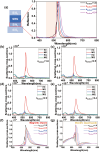Multilayer all-dielectric metasurfaces expanding color gamut
- PMID: 39635036
- PMCID: PMC11449422
- DOI: 10.1515/nanoph-2024-0258
Multilayer all-dielectric metasurfaces expanding color gamut
Abstract
Structural color, arising from the interaction between nanostructures and light, has experienced rapid development in recent years. However, high-order Mie resonances in dielectric materials often induce unnecessary sub-peaks, particularly at shorter wavelengths, reducing the vibrancy of colors. To address this, we have developed a multilayer dielectric metasurface based on silicon-rich silicon nitride (SRN), achieving expanded color gamut through precise refractive index matching and suppression of high-order resonances. This strategy introduces more design dimensions and can reduce the complexity of material deposition. It enables the generation of vibrant colors in a 3 × 3 array, with a resolution of approximately 25,400 dpi, demonstrating its potential applications in displays.
Keywords: high-order resonances; metasurfaces; multipole expansion; silicon-rich silicon nitride; structural color.
© 2024 the author(s), published by De Gruyter, Berlin/Boston.
Conflict of interest statement
Conflict of interest: Authors state no conflicts of interest.
Figures












References
-
- Peters A. T., Freeman H. S., editors. Modern Colorants: Synthesis and Structure . Dordrecht: Springer Netherlands; 1995.
-
- Daqiqeh Rezaei S., et al. Nanophotonic structural colors. ACS Photonics . 2021;8(1):18–33. doi: 10.1021/acsphotonics.0c00947. - DOI
LinkOut - more resources
Full Text Sources
